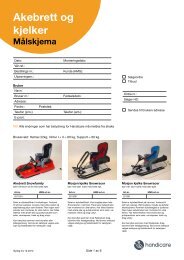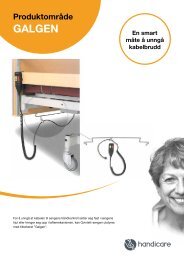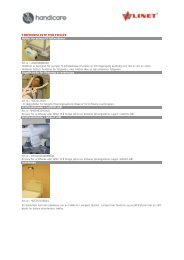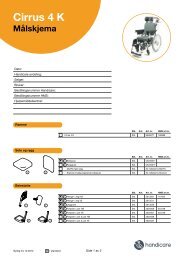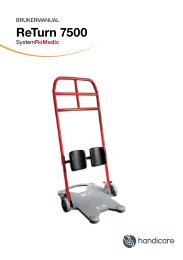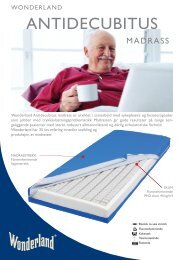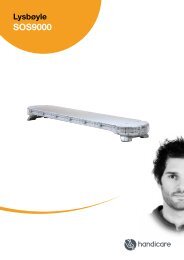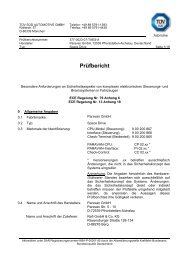1. - Handicare
1. - Handicare
1. - Handicare
Create successful ePaper yourself
Turn your PDF publications into a flip-book with our unique Google optimized e-Paper software.
ISO 9001 D906/ el - en mod.P5/C1<br />
NOTES ON ELECTRONIC EXCHANGE<br />
mod.P5<br />
DIFFERENCES FROM THE EARLIER VERSION:<br />
<strong>1.</strong> The new exchange has 3 relays, instead of one as in the earlier version;<br />
2. The orange wire connected to the microswitch on the brake shaft (for safety<br />
when braking) needs an original earth (e.g. the battery earth; never connect it to<br />
screws or bolts in the coachwork); there is no longer any need for connection to a<br />
+12V positive (earlier version).<br />
Brake-shaft microswitch<br />
Earlier version<br />
Brake-shaft microswitch<br />
Mod.P5 version<br />
3. The working of the motor reducer is anticipated, while the contact of the servo<br />
clutch is delayed and no longer happens at the same time like in the earlier<br />
version; this function can be regulated with potentiometer P5;<br />
4. In the earlier version the sensitivity of the circular potentiometer of the ring was<br />
regulated by potentiometer P2 and the activation of the motor reducer and clutch<br />
contact was therefore controlled by the same relay and potentiometer P2.<br />
These two functions have been separated in the new exchange:<br />
· the motor reducer is regulated by a relay and by potentiometer P2;<br />
· the clutch contact is regulated by a relay and by potentiometer P5.<br />
5. If the accelerator is combined with a servo clutch, use the brown and black wires<br />
of the grey cable to change the contact on the accelerator pedal. The start of the<br />
first stroke of the clutch can be anticipated or delayed by potentiometer P5,<br />
depending on the acceleration desired.<br />
Rev.04 of 26/03/2001 1/35
D906/ el - en mod.P5 /C1 ISO 9001<br />
2/35<br />
Rev.04 of 26/03/2001
ISO 9001 D906/ el - en mod.P5/C1<br />
Rev.04 of 26/03/2001 3/35
D906/ el - en mod.P5 /C1 ISO 9001<br />
BEFORE THE FITTING:<br />
Before mounting it is advisable to connect the device with the loose wires on a bench<br />
to get a clear idea of its connections and operation.<br />
PRECAUTIONS DURING MOUNTING:<br />
<strong>1.</strong> Disconnect the negative pole of the battery.<br />
2. For dismantling the steering wheel and the air bag there is no need to turn the<br />
revolving track that connects the air bag, because it generally only has two turns<br />
to the right and two to the left. Some air bag tracks lock automatically, with a<br />
hook system, once the steering wheel is removed. Other tracks do not have such<br />
a system and you need either to block them in their original position (with insulating<br />
tape) or make sure that the track can make two turns to both right and left<br />
during steering-wheel assembly.<br />
3. The earth of the exchange MUST be connected to the earth of the battery. The<br />
earth brush, relay and microswitch of the brake shaft must be connected to the<br />
original earth (e.g. the battery earth) they should never be connected to screws<br />
or bolts in the coachwork; nearly all problems with the system are caused by<br />
wrong earth connections.<br />
4. Pay particular attention to the path of the accelerator sheath, avoiding bends,<br />
especially very tight ones, because the load of the motor reducer increases with<br />
each bend. Check the tension of the cord by pulling it with your hand on the motorreducer<br />
side: if there is some resistance the motor reducer load will increase and<br />
it will heat up; in this case check the sheath path again to find an alternative one,<br />
as straight as possible.<br />
5. When you have finished mounting the electronic accelerator device it is advisable<br />
to check that it is working properly.<br />
WARNING: if the console is lighting with the vehicle’s battery connected and the air<br />
bag not connected, the corresponding pilot light on the indicator panel will immediately<br />
come on. To return it to zero you have to take the vehicle to the concessionaire.<br />
To avoid this problem, you can connect the air bag before connecting the battery.<br />
4/35<br />
Rev.04 of 26/03/2001
ISO 9001 D906/ el - en mod.P5/C1<br />
SWITCHING ON THE DEVICE:<br />
When the device is switched on the configuration is as follows:<br />
Model P5:<br />
- Green light (GREEN LED) in the electronic box, corresponding to the motor<br />
relay, off<br />
- Red light (RED LED) in the electronic box, corresponding to the clutch contact, off<br />
- Motor reducer NOT powered.<br />
Model C1:<br />
- Red light (RED LED) LED1 on (Electronic box powered)<br />
- Red lights (RED LED) in the electronic box, corresponding to the motor relay, off;<br />
LED2<br />
- Red light (RED LED) in the electronic box, corresponding to the clutch contact,<br />
off; LED3<br />
- Motor reducer NOT powered.<br />
The cable of the motor reducer must not be stretched taut, to avoid “full<br />
stress” before the maximum stroke of Potentiometer P1 has been set in the electronic<br />
box.<br />
Make sure that, when the ring is activated, the motor reducer responds with a<br />
rotation proportional to the ring’s movement.<br />
Rev.04 of 26/03/2001 5/35
D906/ el - en mod.P5 /C1 ISO 9001<br />
6/35<br />
Rev.04 of 26/03/2001
ISO 9001 D906/ el - en mod.P5/C1<br />
Rev.04 of 26/03/2001 7/35
D906/ el - en mod.P5 /C1 ISO 9001<br />
8/35<br />
Rev.04 of 26/03/2001
ISO 9001 D906/ el - en mod.P5/C1<br />
Rev.04 of 26/03/2001 9/35
D906/ el - en mod.P5 /C1 ISO 9001<br />
FUNCTION OF THE CONTROL<br />
POTENTIOMETERS<br />
<strong>1.</strong> RED LED - Clutch Relay; 2. GREEN LED - Motor Reducer Relay;<br />
Setting the final Stroke for the kick-down<br />
For use only on vehicles fitted with automatic<br />
gearshift with a MECHANICAL type Kick-Down<br />
3. CLUTCH RELAY (Contact);<br />
4. MOTOR REDUCER RELAY;<br />
5. SAFETY RELAY (Brake).<br />
Setting the sensitivity of the ring<br />
potentiometer<br />
Setting the motor’s maximum stroke<br />
Setting the activation of the clutch<br />
contact<br />
Do not use just already trimmed<br />
10/35<br />
Rev.04 of 26/03/2001
ISO 9001 D906/ el - en mod.P5/C1<br />
FUNCTION OF THE POTENTIOMETERS<br />
P1: Maximum stroke<br />
P2: Ring sensitivity<br />
P3: Standby position<br />
P4: Final Kick-Down Stroke<br />
(positions 7,8,9 are not<br />
used)<br />
P5: Clutch contact sensitivity<br />
LED1: Electronic box power on<br />
LED2: Motor relay<br />
LED3: Clutch contact<br />
J1: Jumpers regulating<br />
start-stroke<br />
N.B. The use of jumpers J1 is described<br />
on pages 11A and 11B<br />
Setting the maximum motor reducer stroke<br />
Regulating the ring potentiometer sensitivity<br />
Regulating the final stroke for the kick-down<br />
Only for use in vehicles fitted with automatic gearbox<br />
and mechanical type Kick-Down<br />
Regulating the clutch contact drive instead of the<br />
contact on the accelerator pedal<br />
Rev.04 of 26/03/2001 11/35
D906/ el - en mod.P5 /C1 ISO 9001<br />
If the installation is combined with a servo clutch, use the<br />
BROWN 0.75 and BLACK 0.75 cables instead of the tilting<br />
accelerator.<br />
12/35<br />
Rev.04 of 26/03/2001
ISO 9001 D906/ el - en mod.P5/C1<br />
If the installation is combined with a servo clutch, use the BROWN<br />
0.75 and BLACK 0.75 cables instead of the tilting accelerator.<br />
Rev.04 of 26/03/2001 13/35
D906/ el - en mod.P5 /C1 ISO 9001<br />
COMPLETE MOUNTING OF DEVICE 906el/en<br />
The sensitivity (Potentiometer P2) and the standby position (Potentiometer P3) have<br />
already been regulated by GUIDOSIMPLEX; therefore they need no further adjustment.<br />
Regulation must be done strictly in the following order:<br />
<strong>1.</strong> Maximum stroke (Potentiometer P1)<br />
2. KICK-DOWN stroke (Potentiometer P4): for cars with automatic gearbox with<br />
mechanical type KICK-DOWN.<br />
3. Contact for the servo clutch (Potentiometer P5).<br />
REPLACING THE ELECTRONIC BOX ONLY<br />
Regulation must be done strictly in the following order:<br />
<strong>1.</strong> Turn potentiometers P1, P2, P3, P4, P5 ANTICLOCKWISE as far as they will<br />
go. In this condition the LEDs of the exchange are in the following configuration:<br />
LED 1 lit (the electronic box is powered)<br />
LED 2 lit (motor relay active)<br />
LED 3 lit (clutch contact relay active)<br />
2. Turn potentiometer P3 CLOCKWISE to regulate the standby position of the motor<br />
3. Turn potentiometer P2 CLOCKWISE far enough to switch off LED 2<br />
J1<br />
3 2 1<br />
N.B.: Position 3<br />
is not used<br />
14/35<br />
Rev.04 of 26/03/2001
ISO 9001 D906/ el - en mod.P5/C1<br />
4. Turn potentiometer P1 to regulate the maximum stroke of the motor<br />
5. Turn potentiometer P4 to regulate the KICK-DOWN stroke, if the car has<br />
automatic gearbox with a mechanical type KICK-DOWN.<br />
6. Turn Potentiometer P5 to regulate the action of the clutch contact for the first<br />
stroke of the clutch pedal, if the 906el/en device is combined with a GUIDOSIMPLEX<br />
servo clutch.<br />
REGULATING THE INITIAL ACCELERATION<br />
By changing the jumpers on block J1 it is possible to select slow response or fast<br />
response of initial acceleration; depending on the power of the car, this makes it<br />
possible to avoid too abrupt a start for manoeuvres at low speed.<br />
JUMPER IN POSITION 1 AND 2: FAST RESPONSE<br />
ONLY THE JUMPER IN POSITION 2: MEDIUM RESPONSE<br />
NO JUMPER INSERTED:<br />
SLOW RESPONSE<br />
IMPORTANT:<br />
WHEN YOU MOVE THE JUMPERS YOU HAVE TO CHECK AGAIN THAT THE<br />
“INACTIVE POSITION” and “MAXIMUM STROKE” SETTINGS REMAIN UNCHANGED.<br />
Rev.04 of 26/03/2001 15/35
D906/ el - en mod.P5 /C1 ISO 9001<br />
SETTING THE MAXIMUM STROKE OF THE MOTOR REDUCER WITH<br />
POTENTIOMETER P1<br />
<strong>1.</strong> Work on the ring until you obtain the maximum range of the circular potentiometer;<br />
2. Regulate potentiometer P1 to alter the course of the motor reducer so as to<br />
obtain maximum acceleration (the maximum stroke of the motor reducer<br />
is 5.5 cm);<br />
3. When the maximum stroke has been set, check the inactive position of the motor<br />
reducer again, if any variation is found proceed as follows:<br />
• Turn potentiometer P3 either clockwise or anticlockwise to set the inactive<br />
position of the motor reducer;<br />
Setting the inactive position<br />
Setting the maximum stroke of the motor<br />
16/35<br />
Rev.04 of 26/03/2001
ISO 9001 D906/ el - en mod.P5/C1<br />
SETTING THE MAXIMUM STROKE OF THE MOTOR<br />
REDUCER WITH POTENTIOMETER P1<br />
<strong>1.</strong> Work on the ring until you obtain the maximum range of the circular potentiometer;<br />
2. Regulate potentiometer P1 to alter the stroke of the motor reducer so as to<br />
obtain maximum acceleration (the maximum stroke of the motor reducer is 5.5<br />
cm);<br />
Setting the maximum stroke of the motor<br />
Rev.04 of 26/03/2001 17/35
D906/ el - en mod.P5 /C1 ISO 9001<br />
PROCEDURA DI REGOLAZIONE DEL POTENZIOMETRO P4<br />
1) Agire sul potenziometro P1 per variare la corsa del motoriduttore in maniera tale<br />
da determinare l’apertura della farfalla al limite dell’attivazione del kick-down;<br />
2) Azionare il pulsante sulla leva freno e verificare se, l’incremento dell’accelerazione<br />
dovuto ad un successivo spostamento del motoriduttore, sia sufficiente per<br />
l’azionamento del kick-down;<br />
3) Nel caso in cui lo spostamento del motoriduttore non riesca ad attivare il kickdown,<br />
agire sul potenziometro P4 come segue:<br />
Agire sul cerchiello acceleratore per determinare la massima escursione del<br />
potenziometro circolare, premere il pulsante sulla leva freno e verificare il nuovo spostamento<br />
del motoriduttore: in questa configurazione per aumentare o diminuire tale<br />
spostamento agire sul potenziometro P4.<br />
Taratura corsa finale per il kick-down<br />
Da usare solo nelle vetture dotate di cambio<br />
automatico con Kick-Down di tipo MECCA-<br />
NICO<br />
18/35<br />
Rev.04 of 26/03/2001
ISO 9001 D906/ el - en mod.P5/C1<br />
HOW TO REGULATE POTENTIOMETER P4<br />
1) Use potentiometer P1 to change the stroke of the motor reducer so as to cause<br />
the opening of the throttle valve at the limit of the kick-down activation;<br />
2) Press the button on the brake lever and check that the increase in acceleration<br />
due to a subsequent movement of the motor reducer is sufficient for kick-down<br />
activation;<br />
3) If the movement of the motor reducer does not succeed in activating the kickdown,<br />
operate Potentiometer P4 as follows:<br />
Move the accelerator ring to determine the maximum stroke of the circular<br />
potentiometer, press the button on the brake lever and check the new movement of<br />
the motor reducer; in this configuration, use potentiometer P4 to increase or reduce<br />
that movement.<br />
Setting the final stroke for the kick-down<br />
N.B.: Positions 7, 8, 9 of Potentiometer<br />
P4 are not used.<br />
Maximum KICK-DOWN position 0<br />
Minimum KICK-DOWN position 6<br />
Only to be used in vehicles fitted with an<br />
automatic gearbox and MECHANICAL<br />
type Kick-Down<br />
Rev.04 of 26/03/2001 19/35
D906/ el - en mod.P5 /C1 ISO 9001<br />
KICK-DOWN CONNECTION DIAGRAM<br />
1 ST Case: Electric type Kick-Down<br />
Connect the cables coming from the integrated button to the brake lever in parallel<br />
with the other of the original kick-down button.<br />
DO NOT USE<br />
DO NOT USE<br />
20/35<br />
Rev.04 of 26/03/2001
ISO 9001 D906/ el - en mod.P5/C1<br />
KICK-DOWN CONNECTION DIAGRAM<br />
1 st Case: Electrical type KICK-DOWN<br />
Connect the cables coming from the button integrated with the brake lever in parallel<br />
with the cables of the original kick-down button.<br />
DO NOT USE<br />
DO NOT USE<br />
Rev.04 of 26/03/2001 21/35
D906/ el - en mod.P5 /C1 ISO 9001<br />
SCHEMA DI COLLEGAMENTO PER IL KICK-DOWN<br />
2° Caso: Kick-down di tipo meccanico<br />
Taratura corsa finale per il kick-down<br />
Agire sul potenziometro P4 alla massima<br />
escursione e con il pulsante kick-down premuto,<br />
per ottenere il movimento necessario<br />
all’azionamento del kick-down originale.<br />
N.B.: In entrambi i casi di kick-down (elettrico e meccanico), l’escursione massima<br />
regolata con il potenziometro P1 deve essere fatta in modo da fermarsi poco prima<br />
dell’azionamento del kick-down originale. Quest’ultimo sarà attivato solo dal pulsante<br />
previsto sulla leva freno.<br />
22/35<br />
Rev.04 of 26/03/2001
ISO 9001 D906/ el - en mod.P5/C1<br />
KICK-DOWN CONNECTION DIAGRAM<br />
1 st Case: Electrical type KICK-DOWN<br />
Connect the cables coming from the button integrated with the brake lever in parallel<br />
with the cables of the original kick-down button.<br />
DO NOT USE<br />
DO NOT USE<br />
Rev.04 of 26/03/2001 23/35
D906/ el - en mod.P5 /C1 ISO 9001<br />
If a vehicle has an automatic gearbox,<br />
fitted with the original electronic<br />
accelerator pedal, when the kick-down is<br />
included in the pedal potentiometer it<br />
must be regarded as the mechanical type.<br />
Connect the two orange wires of the<br />
control unit directly to the button on the<br />
brake lever.<br />
WARNING<br />
Figure 1: Stroke of the original accelerator pedal<br />
Setting the final stroke for the kick-down<br />
Operate potentiometer P4 at maximum<br />
stroke and with the kick-down button<br />
enabled, to obtain the movement needed<br />
to activate the original kick-down.<br />
N.B. In both kick-down cases (electrical and mechanical), the maximum stroke (full<br />
accelerated) set with potentiometer P1 must be done in such a way that it stops a<br />
little before the original kick-down is activated. The latter can only be activated by the<br />
button on the brake lever.(See figure1)<br />
24/35<br />
Rev.04 of 26/03/2001
ISO 9001 D906/ el - en mod.P5/C1<br />
If a vehicle has an automatic gearbox,<br />
fitted with the original electronic accelerator<br />
pedal, when the kick-down is<br />
included in the pedal potentiometer it<br />
must be regarded as the mechanical type.<br />
Connect the two orange wires of the<br />
control unit directly to the button on the<br />
brake lever.<br />
WARNING<br />
Figure 1: Stroke of the original accelerator pedal<br />
Setting the final stroke for the kick-down<br />
Operate potentiometer P4 at maximum<br />
stroke and with the kick-down button enabled,<br />
to obtain the movement needed to<br />
activate the original kick-down.<br />
N.B. In both kick-down cases (electrical and mechanical), the maximum stroke (full<br />
accelerated) set with potentiometer P1 must be done in such a way that it stops a<br />
little before the original kick-down is activated. The latter can only be activated by the<br />
button on the brake lever.(See figure1)<br />
Rev.04 of 26/03/2001 25/35
D906/ el - en mod.P5 /C1 ISO 9001<br />
SETTING THE CIRCULAR POTENTIOMETER OF THE RING AND<br />
THE CIRCULAR POTENTIOMETER OF THE MOTOR REDUCER<br />
Circular Potentiometer of ring<br />
D906el - There must be a value of<br />
between 6.5 and 6.7 kΩ between the RED<br />
and the BLUE cables when the<br />
Potentiometer is inactive. (Potentiometer<br />
10 kΩ).<br />
Circular Potentiometer of Ring<br />
D906en - There must be a value of<br />
between 6.2 and 6.4 kΩ between the RED<br />
and the BLUE cables when the<br />
Potentiometer is inactive. (Potentiometer<br />
5 k + Resistance in series <strong>1.</strong>8 kΩ).<br />
Circular Potentiometer<br />
of the motor reducer<br />
when inactive<br />
There must be a value of<br />
200 Ω between the<br />
BROWN and YELLOW-<br />
GREEN cables, if the motor<br />
reducer is of the LEFT-HAND<br />
type, or between the BLUE<br />
and YELLOW-GREEN cables<br />
if it is of the right-hand type.<br />
26/35<br />
Rev.04 of 26/03/2001
ISO 9001 D906/ el - en mod.P5/C1<br />
WARNING: To check whether the motor is of the right-hand or left-hand type,<br />
check the arrangement of the power cords and the cables of the circular potentiometer<br />
at positions 4 and 5 of the motor reducer connector, as shown in figs. 1 and 2.<br />
Right Motor Fig.1<br />
Left Motor Fig.2<br />
Rev.04 of 26/03/2001 27/35
D906/ el - en mod.P5 /C1 ISO 9001<br />
SAFETY MICROSWITCH IN THE CASE OF RAPID BRAKING<br />
Microswitch A is active In the event of RAPID BRAKING*: if that happens the<br />
microswitch sends a signal, through the connection with the orange cable, to the<br />
electronic exchange and the exchange cuts off the power to the motor reducer,<br />
which returns to the inactive position (accelerator at minimum).<br />
1 ST PHASE: INSERT SUPPORT B AND REGULATE THE BRAKE SHAFT, LEAVING<br />
THE CORRECT EXHAUST FOR THE BRAKE PUMP;<br />
2 ND PHASE: CONNECT THE CABLES OF MICROSWITCH A TO THE SYSTEM, AS<br />
SHOWN IN THE ATTACHED UNIVERSAL DIAGRAM; (see diagram pages 4 and 5)<br />
• Check that microswitch A is not stressed halfway through braking.<br />
• If spring D is too light (wire section Φ <strong>1.</strong>8 mm.) replace it with the stiffer one<br />
(wire section Φ 2 mm).<br />
REGULATION OF THE THRUST CUP C<br />
The cup must be pressed to the maximum by the braking action, with spring D<br />
compressed and the microswitch activated.<br />
* During GENTLE BRAKING the motor reducer is powered, making control of the<br />
accelerator easy when starting on an upward slope.<br />
28/35<br />
Rev.04 of 26/03/2001
ISO 9001 D906/ el - en mod.P5/C1<br />
WARNING: the earth brush must be connected, even in vehicles equipped<br />
with an earth in the steering shaft. Guidosimplex accepts NO responsibility<br />
if these instructions are not complied with.<br />
<strong>1.</strong> Bore a hole in A with a φ 5 bit, to check the type of steering shaft fitted.<br />
2. Make sure that the shaft on the inside is compatible with the installation of the<br />
earth brush (circular shaft, coloured green in the diagram in the photograph),<br />
otherwise perform the procedure thus far described at point B.<br />
3. If the steering shaft is the right type, widen the hole with a Φ 10 bit; clean the<br />
contact point of the shaft with abrasive paper.<br />
4. Assemble the earth brush as shown in the photograph.<br />
5. Fix the brush, with the support already assembled, to the steering column with a<br />
bail; connect the black cable of the brush to the earth.<br />
Rev.04 of 26/03/2001 29/35
D906/ el - en mod.P5 /C1 ISO 9001<br />
AIR BAG WITH A DOUBLE CIRCULAR TRACK - The original cables of the horn are<br />
generally used for passing the positive and the negative to be connected to the<br />
potentiometer of the ring. Even in that case, YOU MUST FIT the Guidosimplex earth<br />
brush and MAKE the connection shown below (see photographs on page 19).<br />
FAULTS AND TROUBLESHOOTING<br />
30/35<br />
Rev.04 of 26/03/2001
ISO 9001 D906/ el - en mod.P5/C1<br />
Rev.04 of 26/03/2001 31/35
D906/ el - en mod.P5 /C1 ISO 9001<br />
The ring is activated but the motor reducer does not move<br />
1) Check the 10A fuse near the battery located on the RED <strong>1.</strong>5 sq.mm. cable.<br />
2) Use a multiple-purpose tester to check that the ON/OFF switch is working<br />
properly.<br />
POINT A: Make sure that the voltage corresponds to that of the battery (at least<br />
10V). If 0 voltage is found, check the locked socket or the corresponding<br />
original fuse.<br />
POINT B: Make sure that the voltage corresponds to that of the battery (at least<br />
10V). If 0 voltage is found, change the switch.<br />
32/35<br />
Rev.04 of 26/03/2001
ISO 9001 D906/ el - en mod.P5/C1<br />
3) Checking the Relais<br />
POINT A: Make sure that there are 12V.<br />
POINT B: Make sure that there are 12V.<br />
POINT C: Make sure that there are 12V. If 0 voltage is found, check the earth of<br />
the relay; if that is working change the relay.<br />
Rev.04 of 26/03/2001 33/35
D906/ el - en mod.P5 /C1 ISO 9001<br />
3) Checking the Relais<br />
POINT A: Make sure that there are 12V.<br />
POINT B: Make sure that there are 12V.<br />
POINT C: Make sure that there are 12V. If 0 voltage is found, check the earth of<br />
the relay; if that is working change the relay.<br />
34/35<br />
Rev.04 of 26/03/2001
ISO 9001 D906/ el - en mod.P5/C1<br />
4) Checking the electrical connection between the motor reducer, the<br />
exchange and the coil of the motor reducer’s electric motor.<br />
• Check the state of the contacts on the connector;<br />
• To check the coil of the electric motor of the motor reducer, proceed as follows:<br />
- Disconnect the electric connector of the motor reducer from the wiring, measure<br />
the resistance between the RED cable and the BLACK cable; the<br />
multiple-purpose tester should show a value of between 1 and 5 Ω.<br />
- If the multi-purpose tester shows a value of 0 Ω, there is a short-circuit on the coil.<br />
- If the resistance value shown is very high, either the coil is interrupted or the<br />
brushes have deteriorated.<br />
Rev.04 of 26/03/2001 35/35
D906/ el - en mod.P5 /C1 ISO 9001<br />
5) Checking the reducer<br />
If, when the ring is activated, the shaft starts rotating but the tie rod does not follow<br />
in the movement, it means the reducer is out of order.<br />
36/35<br />
Rev.04 of 26/03/2001




